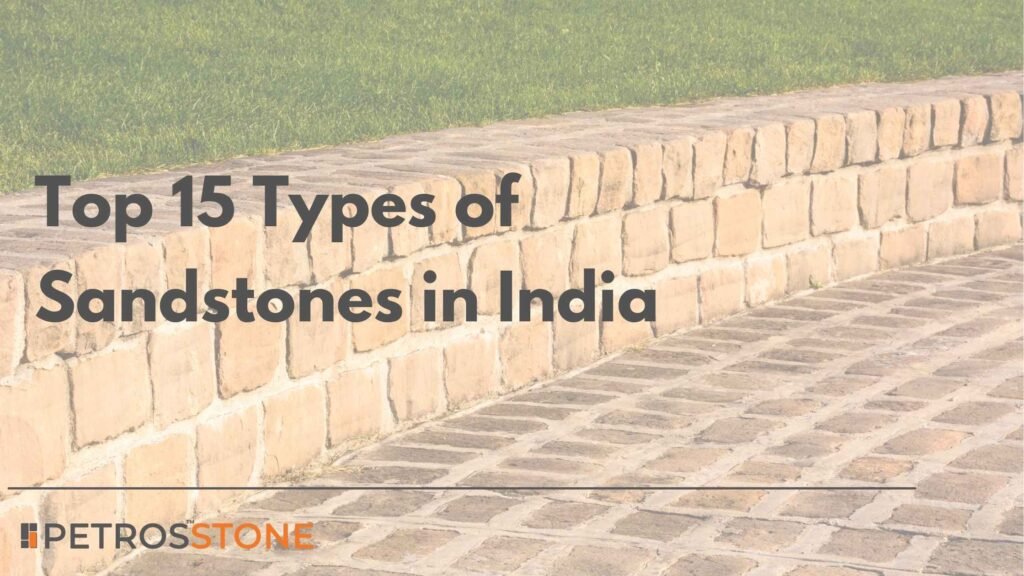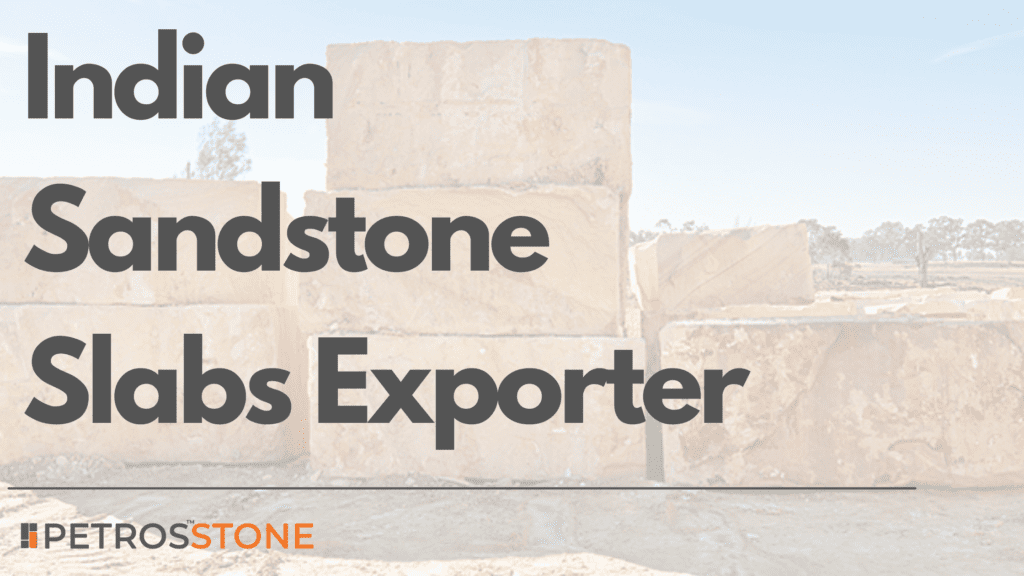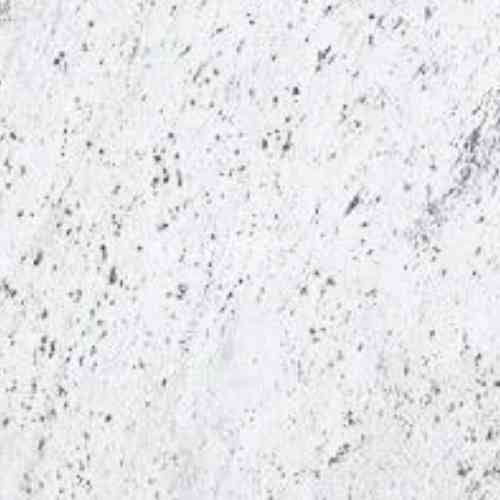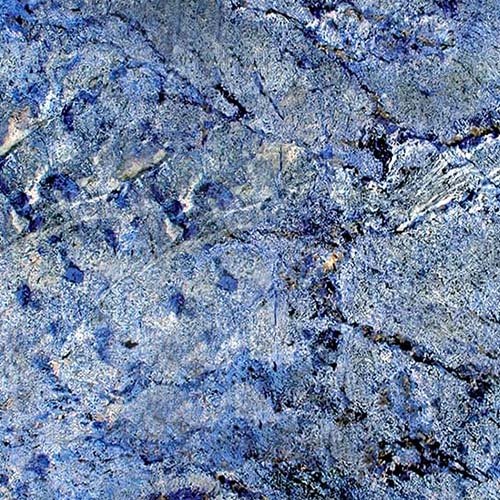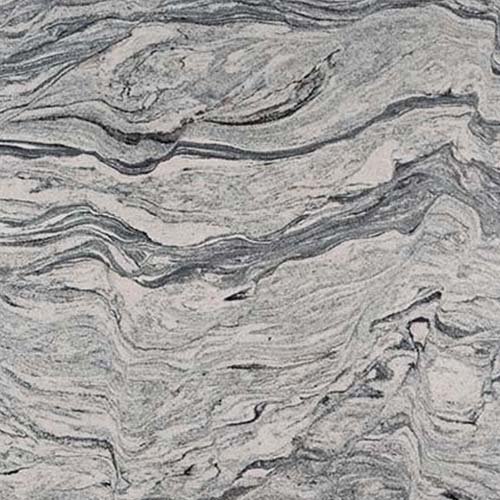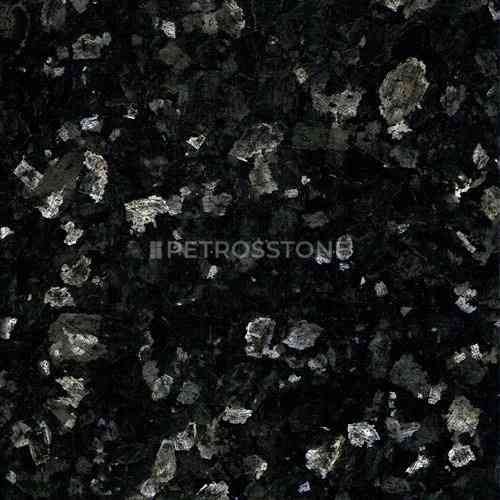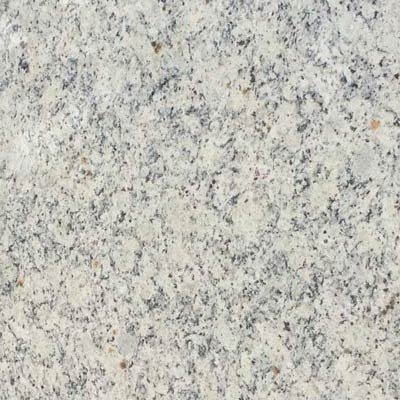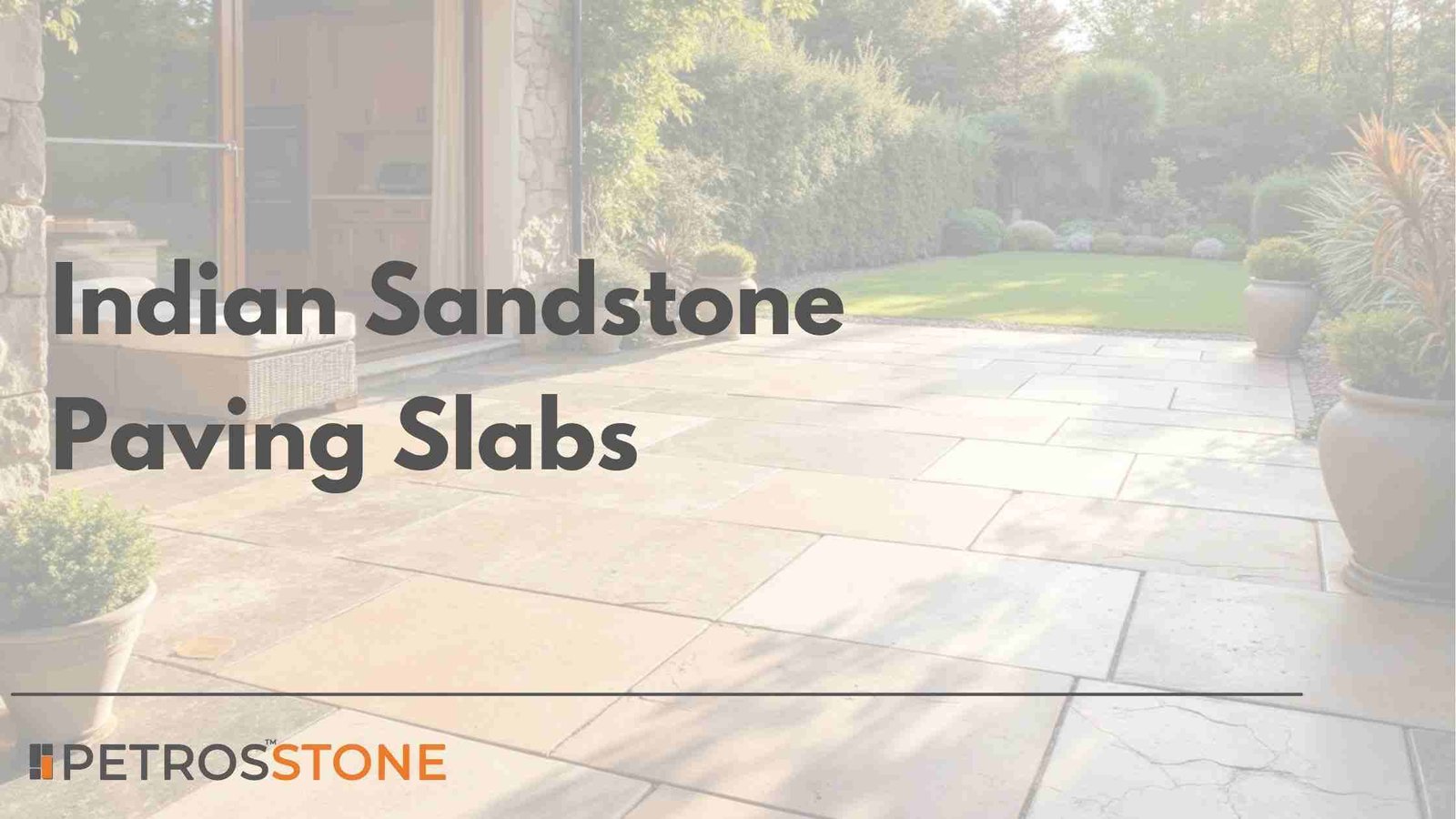
Indian sandstone has emerged as one of the most sought-after natural stone materials for outdoor paving projects, combining timeless aesthetic appeal with practical durability. This sedimentary rock, formed over millions of years from compressed sand particles, offers homeowners and landscapers an exceptional balance of beauty, functionality, and value, which has made it a global favorite for patios, walkways, driveways, and garden paths.
Indian Sandstone Paving Slabs Price Chart
| Category | Finish Type & Quality | Common Colors / Varieties | Average Price (USD / sqm) | Typical Applications |
|---|---|---|---|---|
| Basic Grade | Riven finish, natural edges, 22mm calibrated | Mint, Kandla Grey, Raj Green | $12 – $16 / sqm | Patios, garden paths, courtyards |
| Mid-Range Grade | Sawn or honed finish, uniform thickness | Teakwood, Dholpur Beige, Camel Dust | $15 – $20 / sqm | Walkways, pool decks, outdoor seating areas |
| Premium Grade | Large format, smooth calibrated slabs, rare colors | Rainbow, Fossil Mint, Chocolate Sandstone | $17 – $25 / sqm | Designer patios, luxury outdoor landscapes |
| Commercial-Use Grade | Heavy-duty thickness (25–30mm), riven or sawn | Red Sandstone, Kandla Grey | $20 – $28 / sqm | Driveways, public walkways, architectural paving |
| Export Grade (FOB) | Calibrated, hand-cut or machine-sawn | Mixed finishes, all colors | $18 – $30 / sqm (FOB) | Export markets (UK, EU, Australia, US) |
In this article, we explore everything you need to know about Indian Sandstone Paving Slabs, from their formation and natural beauty to the types, finishes, sizes, and prices available in India. You’ll discover the unique qualities of popular varieties like Mint, Teakwood, Rainbow, and Kandla Grey Sandstone, and understand how to select, install, and maintain these stones for long-lasting outdoor elegance.
We’ll also compare Indian sandstone with alternatives like limestone and granite, and share practical buying tips to help you source the right material for your project. Whether you’re a homeowner, architect, or landscaper, this comprehensive guide will help you make an informed and confident choice.
- Understanding Indian Sandstone
- Indian Sandstone Paving Slab Varieties
- 1. Mint Sandstone
- 2. Teakwood Sandstone
- 3. Rainbow Sandstone
- 4. Red Sandstone
- 5. Kandla Grey Sandstone
- 6. Dholpur Beige Sandstone
- 7. Fossil Mint Sandstone
- 8. Chocolate Sandstone
- 9. Camel Dust Sandstone
- 10. Raj Green Sandstone
- Indian Sandstone Finish Types
- Standard Sizes and Dimensional Specifications of Sandstone Pavers
- Common Dimensional of Sandstone Pavers
- Thickness Specifications and Tolerances
- Domestic Indian Market Pricing
- Indian Sandstone Paving Slabs – Price Chart
- Key Advantages of Indian Sandstone Paving
- Safety and Slip Resistance
- Thermal Properties and Comfort
- Aesthetic Versatility
- Comparative Aspects of Sandstone and Alternative Materials
- Indian Sandstone vs. Granite
- Indian Sandstone vs. Manufactured Alternatives
- Buying Guidelines and Quality Control
- Summary
- Key Takeaways
Understanding Indian Sandstone
Indian sandstone is a clastic sedimentary rock that consists largely of sand-sized grains of silica that have been naturally cemented together through ages of geological time.
The formation of the stone takes place when tiny sand grains, which have been produced by the physical and chemical weathering of the bedrock in mountainous and volcanic areas, are carried by wind or water to other environments by deposition.
The diverse stratified structures and colors of Indian sandstone result from the different environmental conditions during its formation, which vary in terms of pressure, temperature, sand content, and mineral composition. The presence of silica and feldspar in the stone, both of which minerals are highly resistant to weathering, has resulted in its durability and its permanency in time and condition.
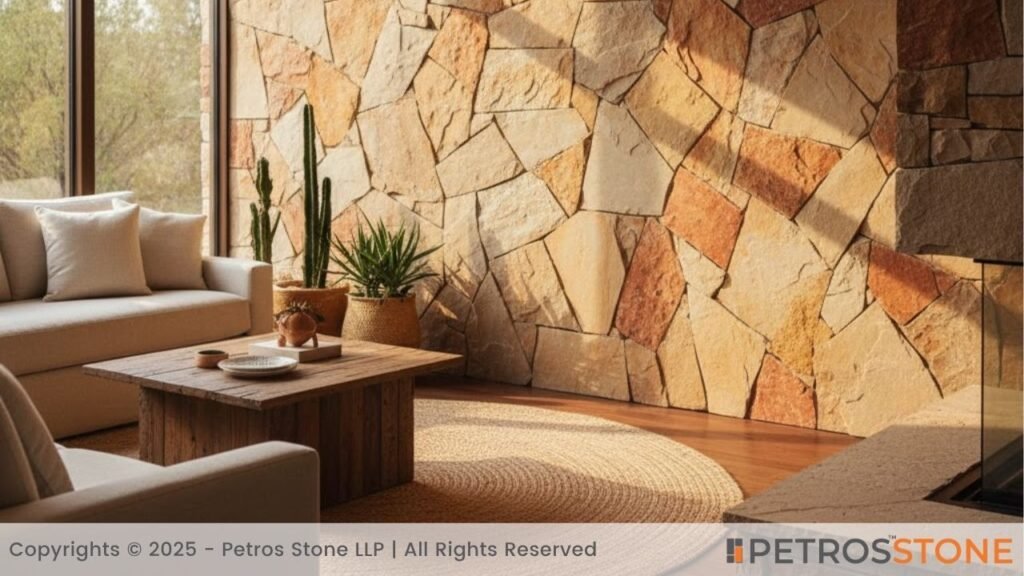
Indian Sandstone Paving Slab Varieties
The differences in the varieties of Indian sandstones are largely due to the different localities of quarry supplies, which produce distinctive features of variation as follows:
1. Mint Sandstone
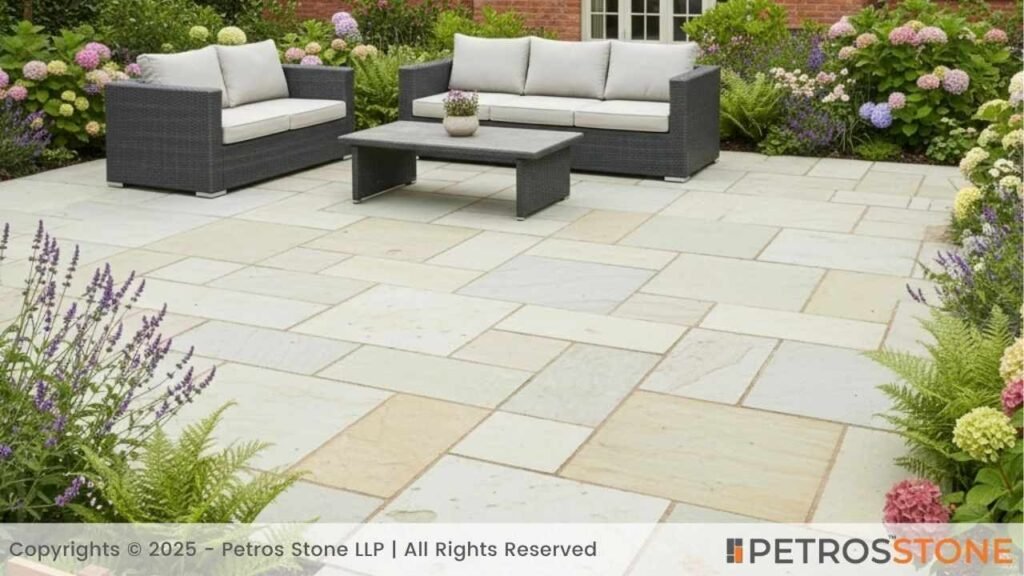
Mint Sandstone, also known as Fossil Mint or Gwalior Mint, is prized for its soothing cream-to-beige hues and naturally embedded fossil patterns. Its subtle tones create a bright, inviting outdoor atmosphere, especially in gardens, courtyards, and pool areas. The stone is naturally slip-resistant and highly durable, making it perfect for patios and walkways. Though moderate in stain resistance, sealing once every few years enhances longevity and color retention. With its blend of elegance and practicality, Mint Sandstone remains one of the most sought-after choices for homeowners and landscapers alike.
Key Attributes
| Appearance | Cream to light beige with fossil patterns |
| Cost | $11 – $20/sqm |
| Stain Resistance | Moderate |
| Scratch Resistance | High |
| Strength | Excellent, ideal for outdoor use |
2. Teakwood Sandstone
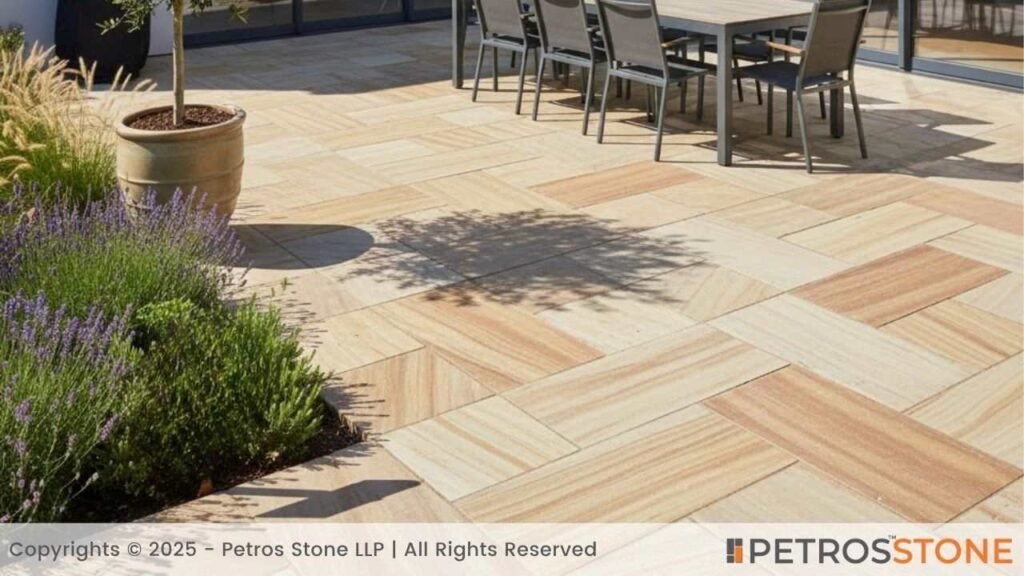
Teakwood Sandstone stands out for its natural wooden appearance — golden-yellow bands resembling real teak timber. This stone offers the warmth of wood with the durability of stone, making it ideal for garden paths, courtyards, and accent walls. Its dense structure provides good resistance to wear, though it’s best sealed to prevent water absorption. Highly favored for design versatility, Teakwood Sandstone complements both rustic and contemporary themes, delivering natural elegance and endurance in high-use outdoor spaces.
Key Attributes
| Appearance | Golden-yellow with teak-like grain |
| Cost | $11 – $20/sqm |
| Stain Resistance | High |
| Scratch Resistance | Moderate |
| Strength | High, suitable for high-traffic areas |
3. Rainbow Sandstone
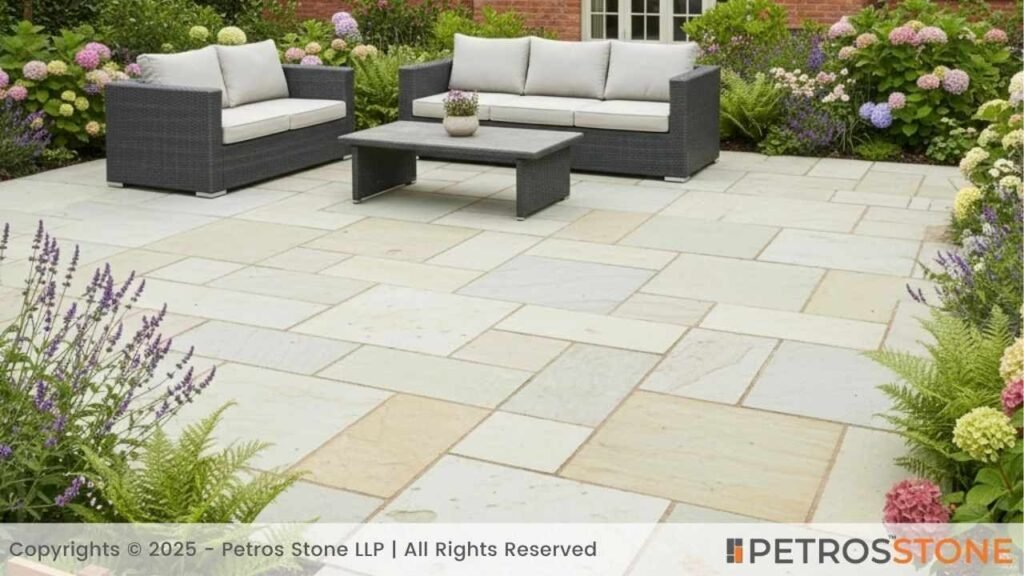
Rainbow Sandstone is a visual masterpiece from India, featuring dramatic swirls of red, violet, brown, and gold. Each slab has a unique, wood-grain-like pattern that makes it an instant focal point in patios or feature walls. While its surface is durable and scratch-resistant, it benefits from sealing to prevent moisture absorption and color fading. Ideal for clients seeking bold aesthetics, Rainbow Sandstone transforms ordinary outdoor areas into expressive landscapes bursting with natural character.
Key Attributes
| Appearance | Swirling mix of red, violet, and gold |
| Cost | $11 – $20/sqm |
| Stain Resistance | Low |
| Scratch Resistance | High |
| Strength | Requires sealing for durability |
4. Red Sandstone
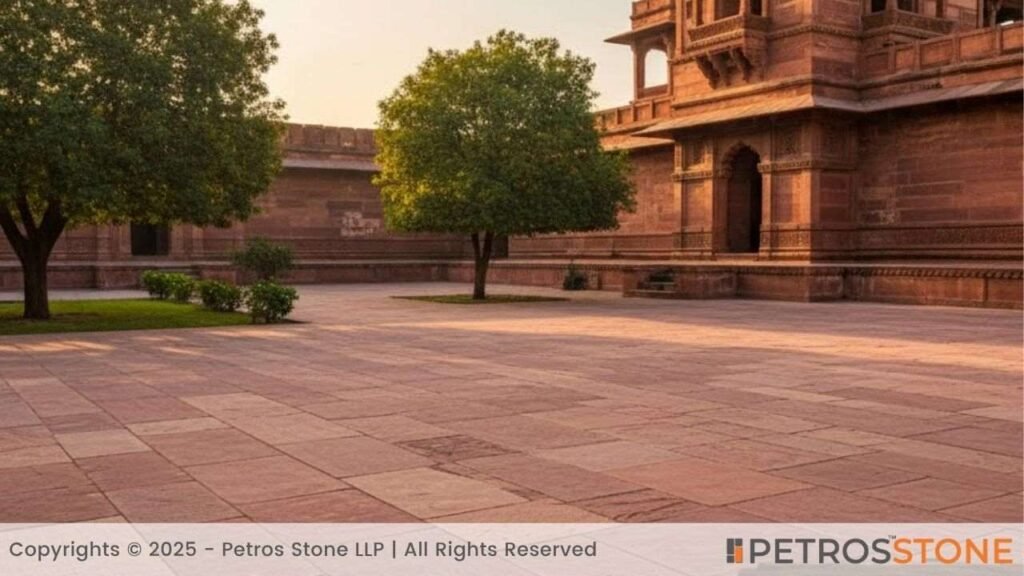
Red Sandstone, famously used in the Red Fort and Fatehpur Sikri, embodies India’s architectural heritage. Its rich terracotta tone exudes timeless warmth and grandeur. This stone is incredibly tough, weather-resistant, and suitable for both paving and cladding. Its fine-grained surface withstands wear, making it ideal for heavy foot traffic. With its regal look and lasting durability, Red Sandstone continues to be a favorite for both traditional and modern architectural projects across the globe.
Key Attributes
| Appearance | Deep terracotta red |
| Cost | $11 – $20/sqm |
| Stain Resistance | Moderate |
| Scratch Resistance | High |
| Strength | Excellent, used in heritage structures |
5. Kandla Grey Sandstone
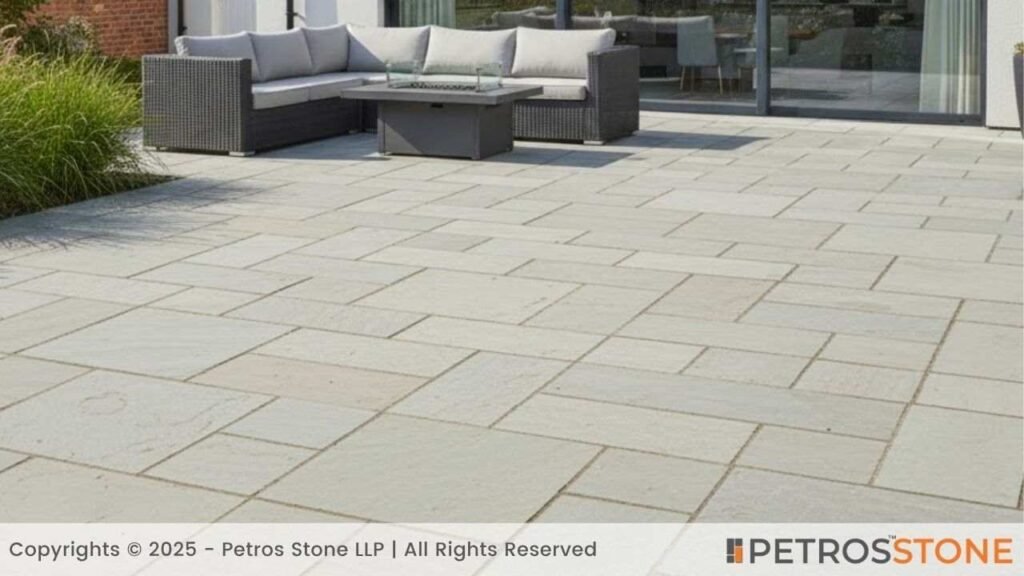
Kandla Grey Sandstone, also called Silver Grey Sandstone, is the most popular choice for modern paving projects. Its neutral tone blends beautifully with both brick and timber architecture. Known for exceptional durability, this sandstone withstands frost, rain, and heat, maintaining its natural texture for years. Its non-slip surface makes it ideal for driveways, patios, and pool decks. The subtle elegance of Kandla Grey provides a versatile foundation for any outdoor design theme, from contemporary minimalism to classic landscaping.
Key Attributes
| Appearance | Uniform light to mid-grey |
| Cost | $11 – $20/sqm |
| Stain Resistance | High |
| Scratch Resistance | High |
| Strength | Excellent for weather resistance |
6. Dholpur Beige Sandstone
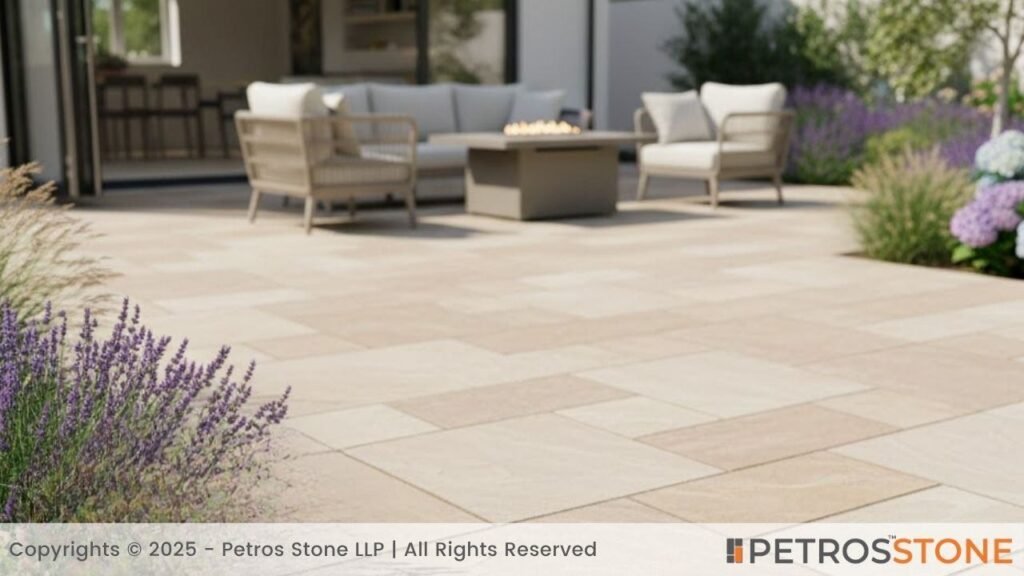
Dholpur Beige Sandstone is celebrated for its soft, consistent beige shade that radiates warmth and simplicity. Quarried in Rajasthan, this sandstone’s uniform texture and smooth surface make it ideal for cladding, paving, and architectural detailing. It’s relatively lightweight, which simplifies installation. Though moderate in stain resistance, periodic sealing ensures long-term beauty. Its understated elegance makes it perfect for institutional and residential facades where subtlety is key.
Key Attributes
| Appearance | Light beige and smooth texture |
| Cost | $11 – $20/sqm |
| Stain Resistance | Moderate |
| Scratch Resistance | Moderate |
| Strength | Strong but lightweight |
7. Fossil Mint Sandstone
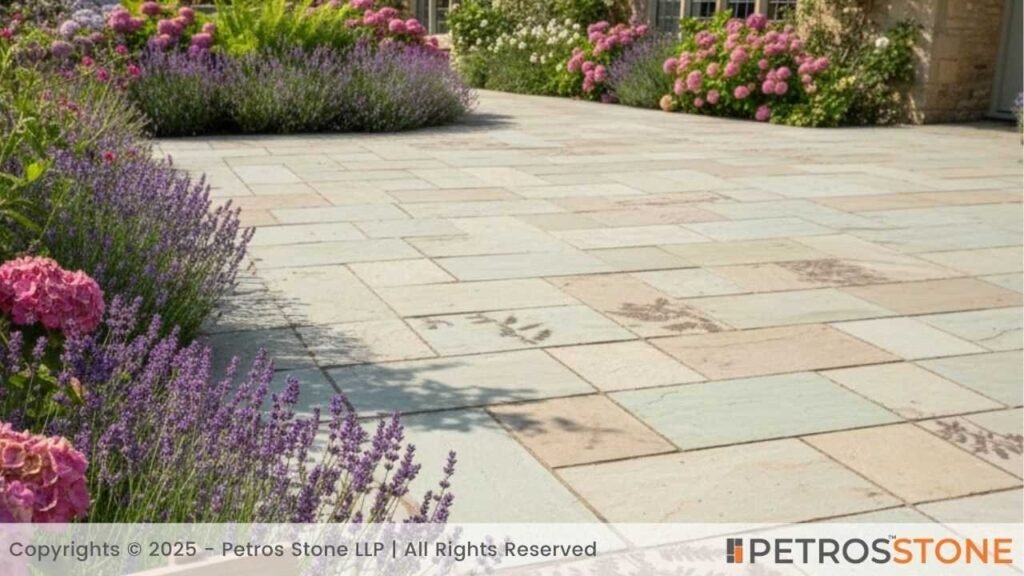
Fossil Mint Sandstone is a unique natural stone featuring ancient leaf and fern imprints, adding character to every slab. The beige-to-cream base gives a warm, organic appeal suitable for gardens and outdoor living areas. While the surface is durable and scratch-resistant, it’s best sealed to protect against staining. Its fossilized charm creates a connection between natural history and modern design, making it a preferred choice for those seeking beauty with a story.
Key Attributes
| Appearance | Beige base with fossil imprints |
| Cost | $11 – $20/sqm |
| Stain Resistance | Low |
| Scratch Resistance | High |
| Strength | Best sealed for outdoor use |
8. Chocolate Sandstone
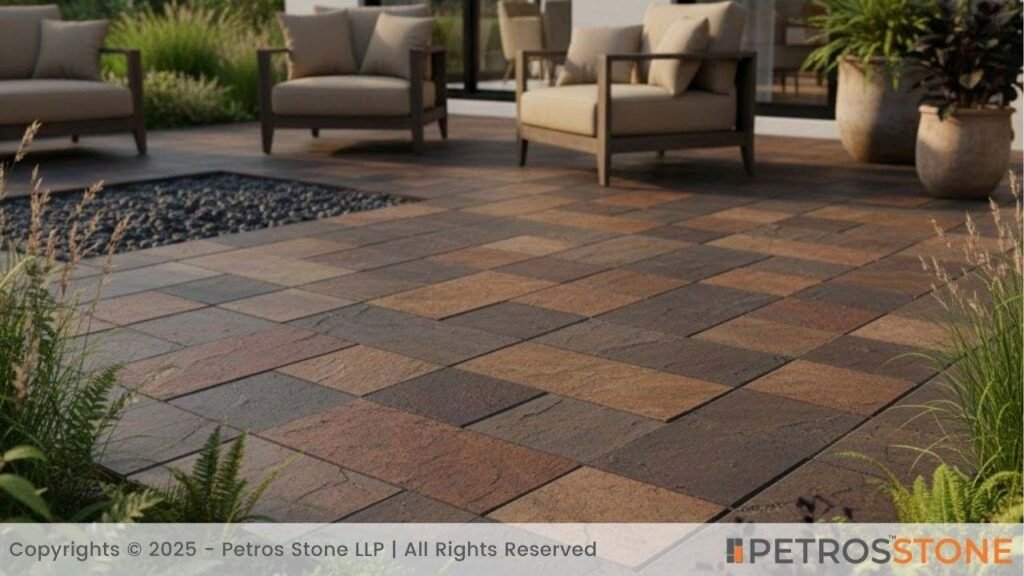
Chocolate Sandstone exudes warmth and richness through its deep brown tones and gentle variations. It’s often used to create contrast in paved courtyards or as a complementary feature with lighter stones. With excellent compressive strength, it performs well under pressure, though moderate scratch resistance calls for gentle handling during installation. This stone brings an earthy charm and luxurious warmth to exterior spaces, perfectly balancing aesthetics and resilience.
Key Attributes
| Appearance | Rich brown with subtle shade variation |
| Cost | $11 – $20/sqm |
| Stain Resistance | High |
| Scratch Resistance | Moderate |
| Strength | High, ideal for accents |
9. Camel Dust Sandstone
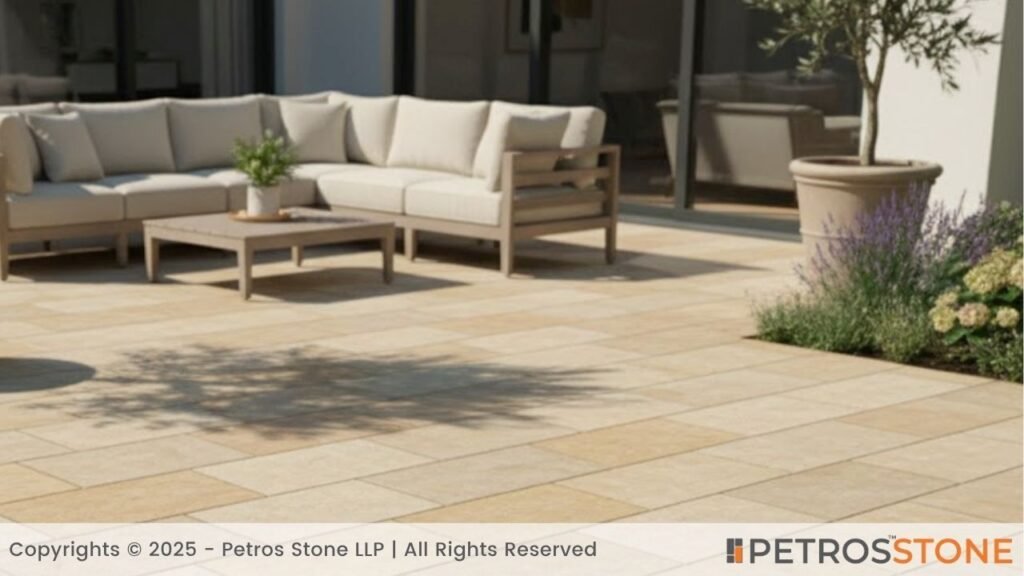
Key Attributes
| Appearance | Warm golden-beige tones |
| Cost | $11 – $20/sqm |
| Stain Resistance | Moderate |
| Scratch Resistance | High |
| Strength | Subtle elegance for patios |
Camel Dust Sandstone, also known as Desert Sandstone, features a soothing palette of gold, cream, and light brown tones reminiscent of desert landscapes. Its gentle warmth adds a natural softness to outdoor environments. The stone’s high scratch resistance makes it durable for pathways and patios. It is moderately resistant to stains, and sealing enhances protection. With its refined texture and earthy shades, Camel Dust creates effortlessly elegant and welcoming outdoor settings.
10. Raj Green Sandstone
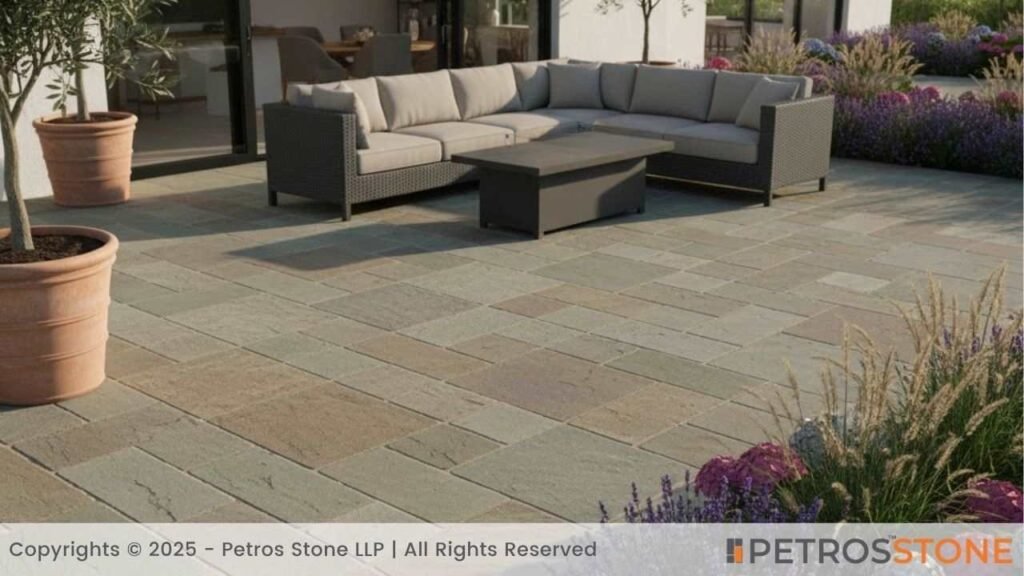
Raj Green Sandstone is a classic favorite for its natural blend of greens, browns, and subtle purples, reminiscent of traditional British countryside paving. Its high strength and weather resistance make it perfect for patios, pathways, and driveways. The stone’s natural variation enhances charm and authenticity in any setting. Resistant to both scratches and stains, Raj Green Sandstone combines longevity with timeless beauty — a top pick for elegant, enduring outdoor designs.
Key Attributes
| Appearance | Olive green, brown, and plum hues |
| Cost | $11 – $20/sqm |
| Stain Resistance | High |
| Scratch Resistance | High |
| Strength | Excellent for outdoor settings |
Indian Sandstone Finish Types
Riven Finish
The naturally split surface contributes to the stone’s structural homogeneity and creates an interior texture formed when the sandstone was separated along its natural sedimentary seams, or bedding. Riven surfaces create excellent anti-slip conditions and provide a uniform appearance to the pavement, which features a perfect color resembling a natural rustic style suitable for both heritage and contemporary garden designs.
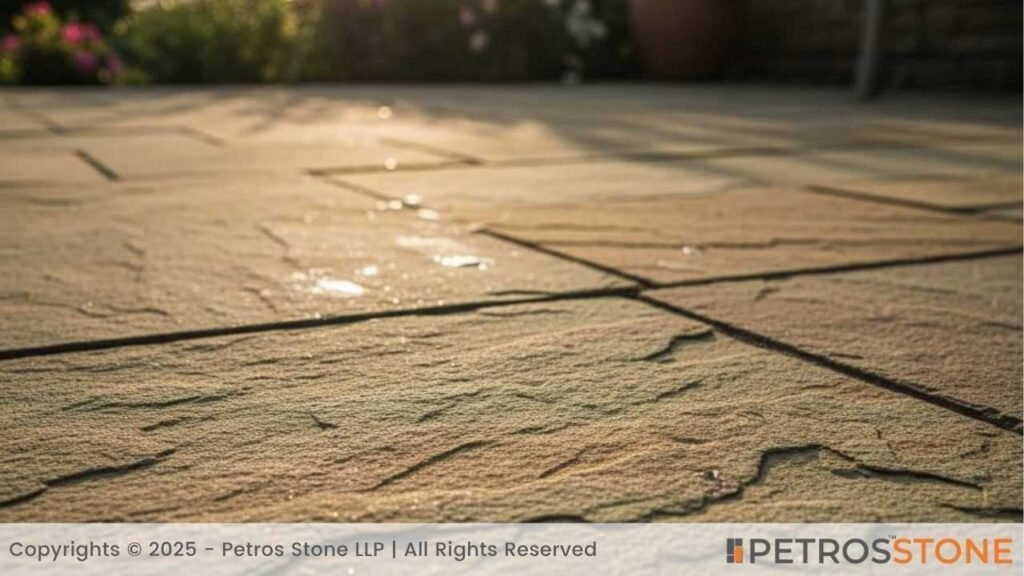
Sawn and Honed Finish
This finish gives a machine-cut surface with a smooth finish, which is adapted for modern patio installations where homogeneity and clean linear outlines are sought. The clean sawn edges produce a regular union to aid in the construction process and produce precise surface lines.
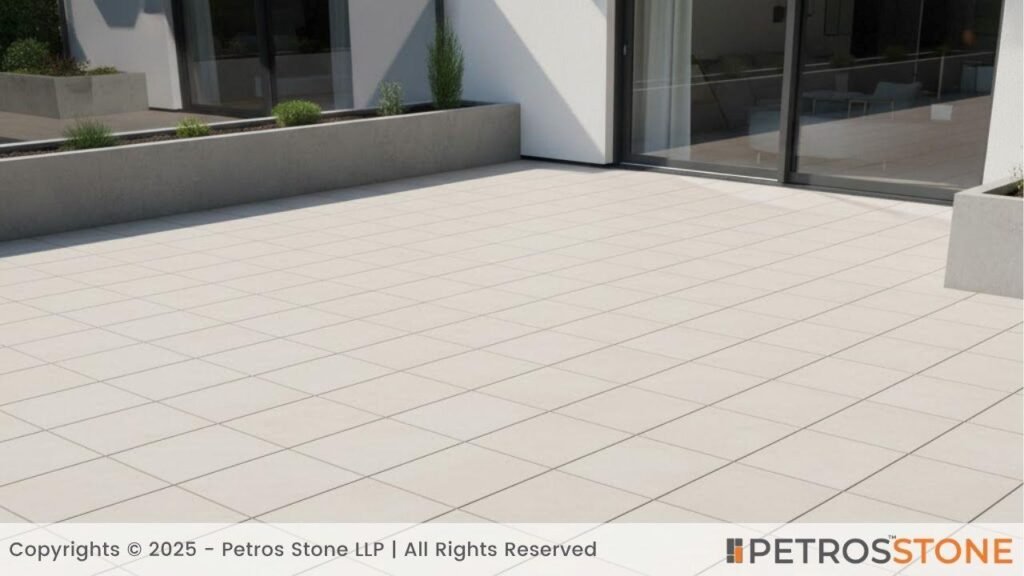
Calibrated Finish
This is probably the most popular method employed by many of the professional installations of Indian sandstones, in that it produces uniformly thick slabs (usually 18-22mm) with riven or sawn surface finishes. This calibration can uniformly reduce the time and complication of the installation process, and they are, therefore, the normal contractual choice for commercially large schemes of thickness.
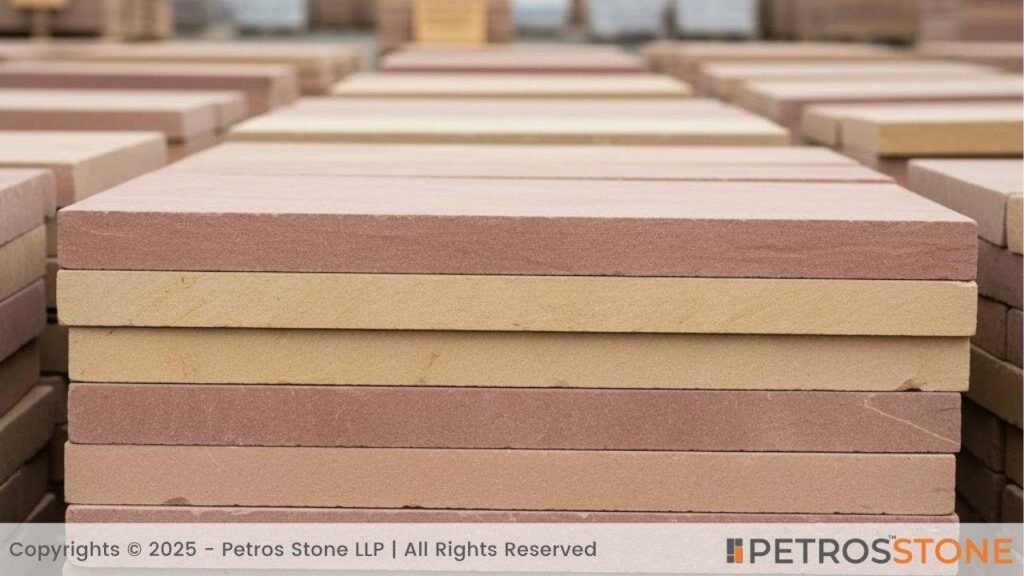
Standard Sizes and Dimensional Specifications of Sandstone Pavers
Indian sandstone paving slabs are manufactured in various standardized sizes to accommodate different design requirements and installation preferences:
Common Dimensional of Sandstone Pavers
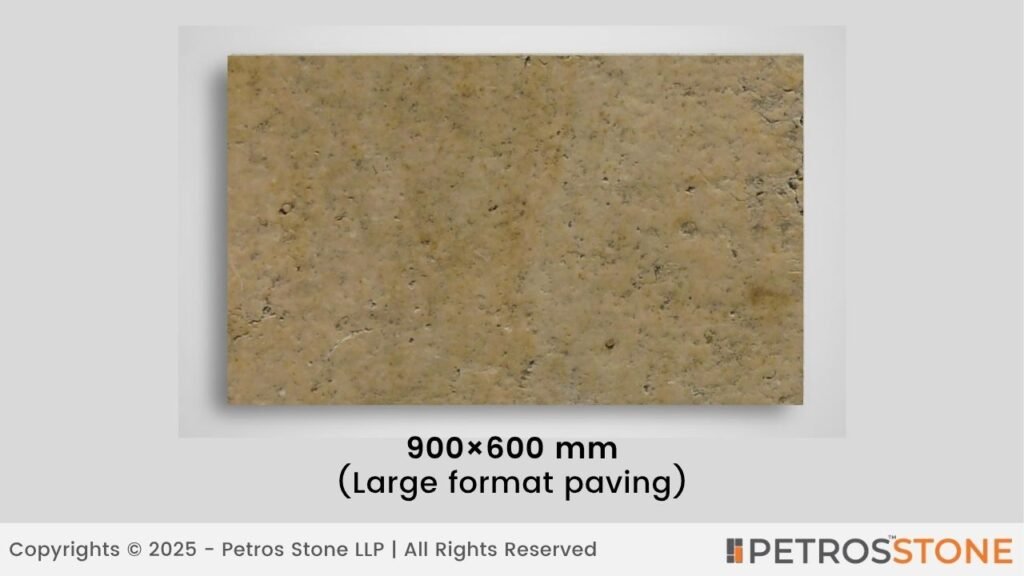
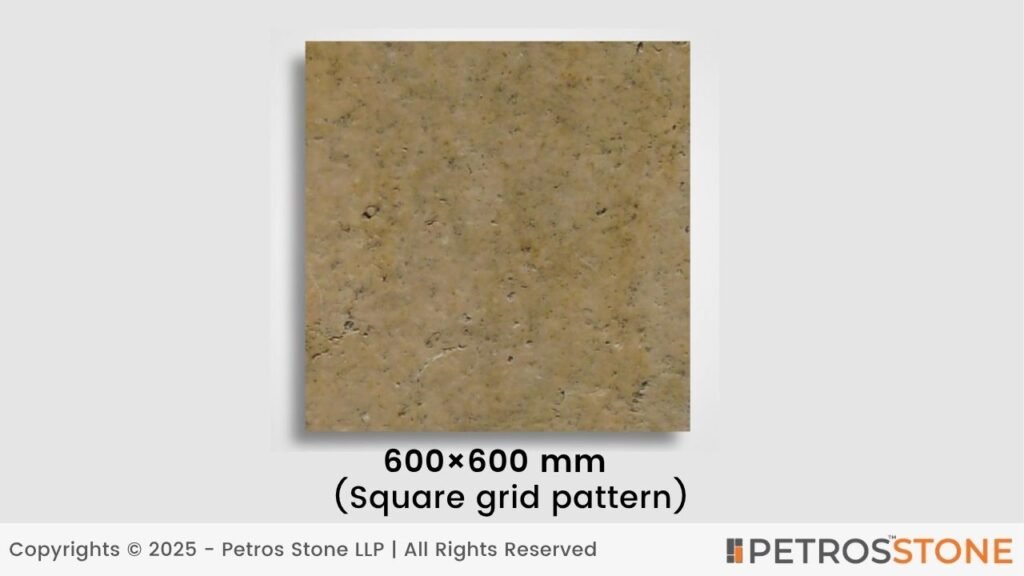
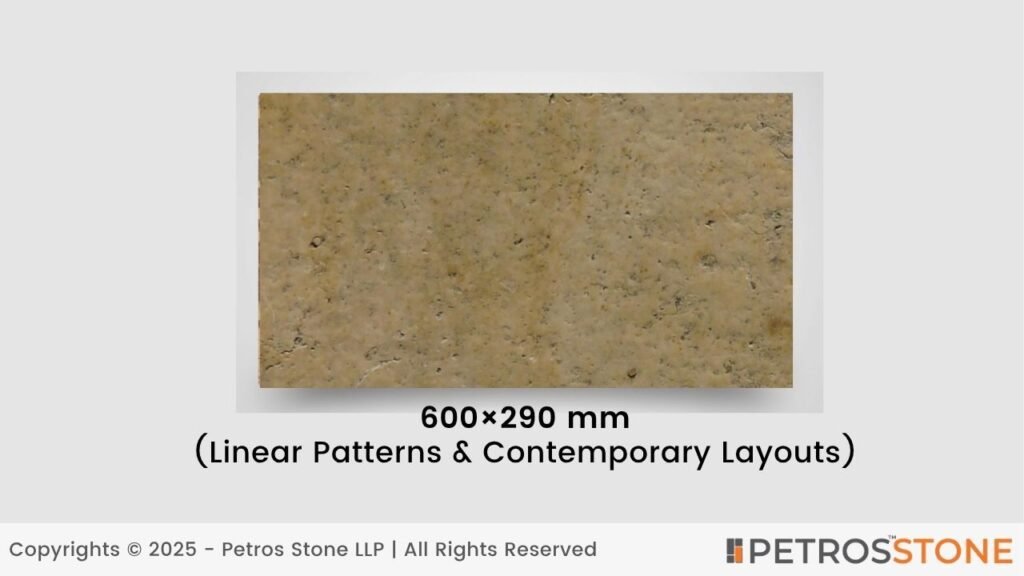
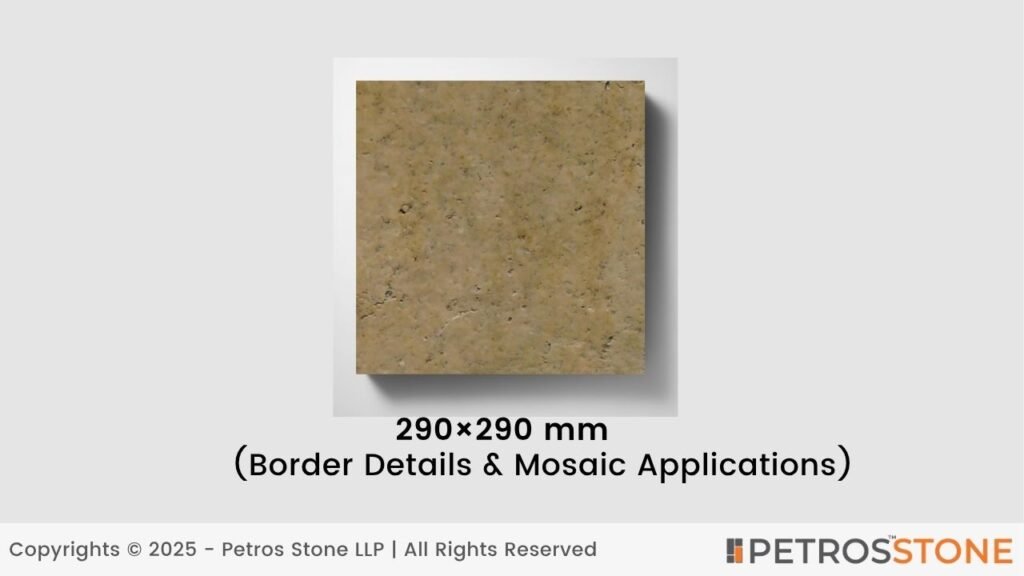
Table for Common Dimensional Options
| Size (mm) | Typical Applications | Coverage per Pack | Standard Thickness |
| 900×600 | Large patios, expansive areas | 18.22 m² (34 pieces) | 22mm calibrated |
| 600×600 | Uniform grid patterns, formal designs | 13.68 m² (38 pieces) | 22mm calibrated |
| 600×290 | Linear patterns, contemporary layouts | Variable pack sizes | 18-22mm |
| 290×290 | Border details, mosaic applications | High piece count | 18-22mm |
Thickness Specifications and Tolerances
Almost all Indian sandstone paving have a typical calibrated thickness of 22 mm. The tolerance of natural stone products is, as a rule, ±4-5 mm through every slab; this is considered to be normal and should not affect the ease of laying.
On heavy-duty work, such as driveways, or where there are heavy loads to support, such as in commercial buildings, a thickness of 25–30 mm can be laid, which will take these added loads.
The weights of slabs based on the standard 22-mm thickness work out to about 50–55 kg per square meter. A full pallet will therefore weigh between 715kg and over 1000kg, depending on size and packing.
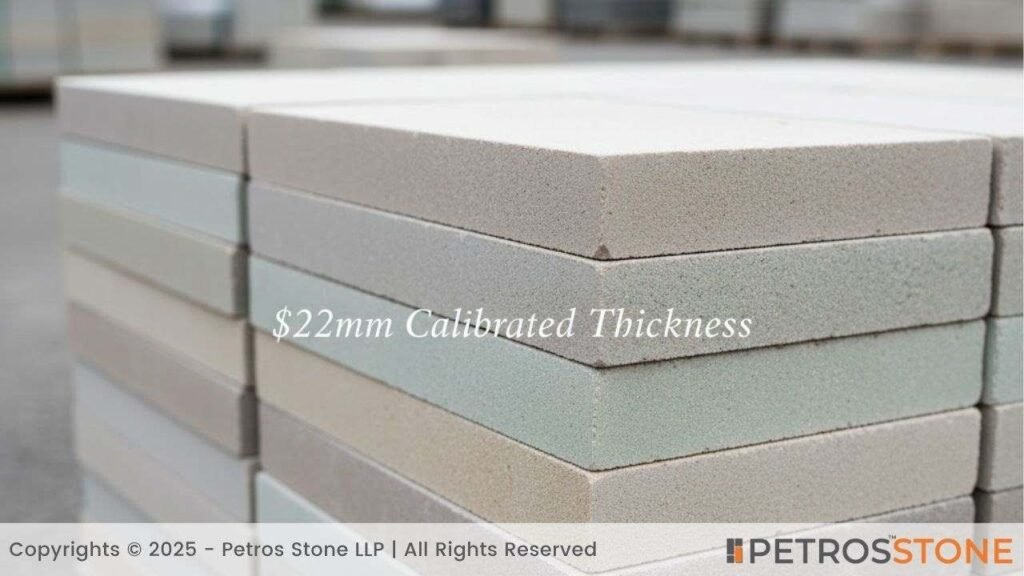
Domestic Indian Market Pricing
The pricing level for Indian sandstone paving in India is very competitive and depends basically upon the grade of quality, the type of finish, the type of stone and local availability:
Basic Grade Pricing (Riven finish, standard colors)
- ₹400-₹450 per square meter (approximately ₹37-₹42 per square foot)
- Export FOB prices: $12-$16 per square meter
Mid-Range Pricing (Sawn edges, calibrated thickness)
- ₹450-₹550 per square meter (approximately ₹42-₹51 per square foot)
- Export FOB prices: $15-$20 per square meter
Premium Grade Pricing (Large format, specialized finishes, rare colors)
- ₹550-₹800 per square meter (approximately ₹51-₹74 per square foot)
- Export FOB prices: $17-$25 per square meter
Indian Sandstone Paving Slabs – Price Chart
| Category | Finish Type & Quality | Common Colors / Varieties | Average Price (USD / sqm) | Typical Applications |
|---|---|---|---|---|
| Basic Grade | Riven finish, natural edges, 22mm calibrated | Mint, Kandla Grey, Raj Green | $12 – $16 / sqm | Patios, garden paths, courtyards |
| Mid-Range Grade | Sawn or honed finish, uniform thickness | Teakwood, Dholpur Beige, Camel Dust | $15 – $20 / sqm | Walkways, pool decks, outdoor seating areas |
| Premium Grade | Large format, smooth calibrated slabs, rare colors | Rainbow, Fossil Mint, Chocolate Sandstone | $17 – $25 / sqm | Designer patios, luxury outdoor landscapes |
| Commercial-Use Grade | Heavy-duty thickness (25–30mm), riven or sawn | Red Sandstone, Kandla Grey | $20 – $28 / sqm | Driveways, public walkways, architectural paving |
| Export Grade (FOB) | Calibrated, hand-cut or machine-sawn | Mixed finishes, all colors | $18 – $30 / sqm (FOB) | Export markets (UK, EU, Australia, US) |
Key Advantages of Indian Sandstone Paving
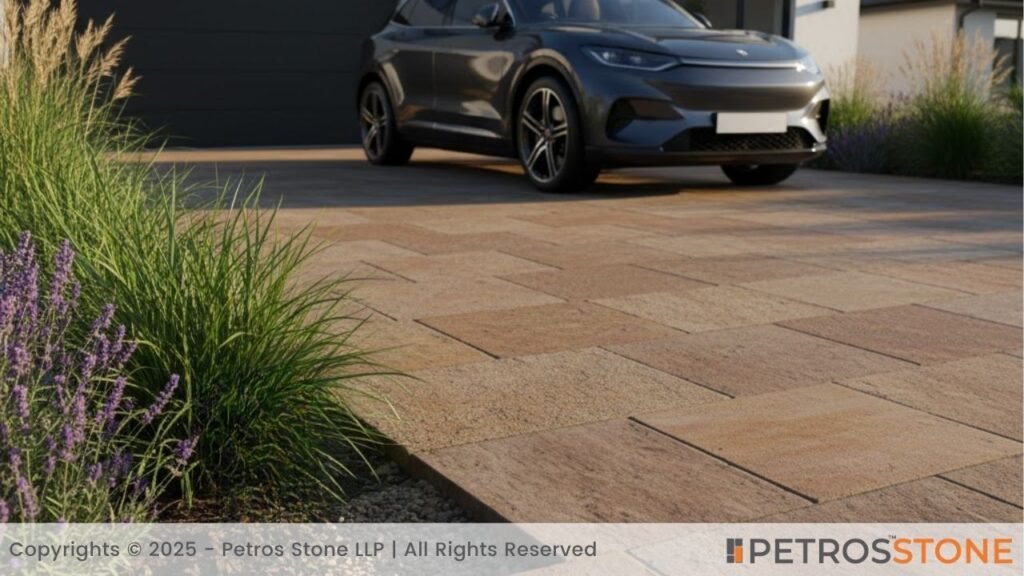
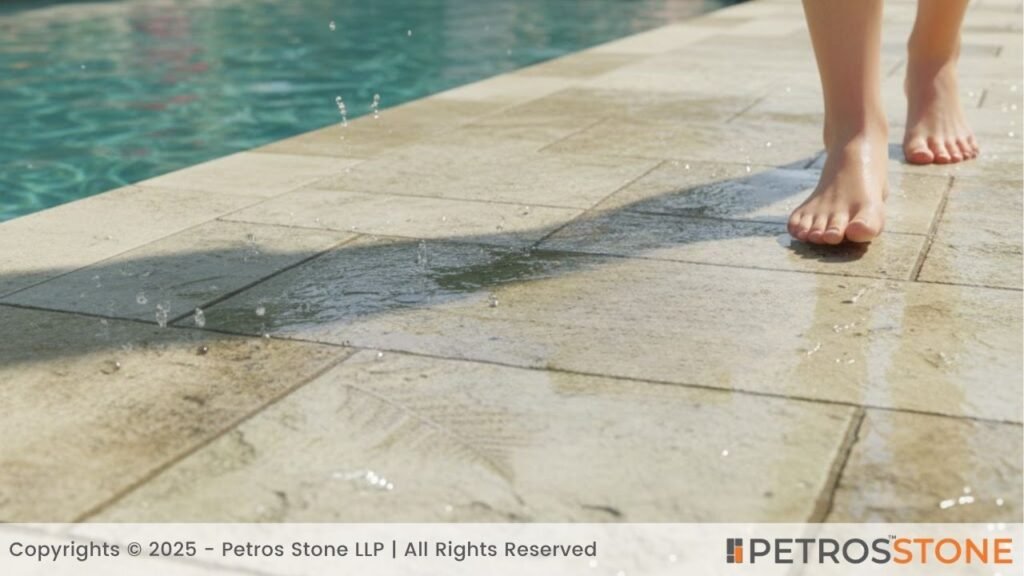
Durability and Weather Resistance
Indian sandstone has natural characteristics of durability, rendering it suitable for all varieties of climate. Being rated as 6-7 on the Mohs hardness scale and having excellent strength in compression, it has the power to withstand heavy pedestrian traffic and heavy vehicle traffic when laid correctly.
The natural structure in which it occurs gives it a high resistance to ice and thawing, making it most suitable for areas experiencing severe cold conditions. It is particularly suitable for regions that undergo significant temperature changes.
The weathering properties of the material refer to its natural resistance to weathering processes occurring within its geological composition, especially due to The quartz and feldspar minerals help maintain the integrity of the material against these processes.
With proper maintenance, Indian sandstone installations can last 20–30 years or more, providing exceptional long-term value for outdoor projects.
Safety and Slip Resistance
One of the greatest assets of the Indian sandstone is the fact that it has natural non-slip properties, particularly in riven finishes. The rough, naturally cleft surface offers superior natural traction, even when wet. This makes it significantly safer than smooth alternatives like polished porcelain or concrete. These qualities make it extremely useful for swimming pool environments where safety is a top priority.
Thermal Properties and Comfort
Indian sandstone is found to have superior thermal characteristics compared to manufactured materials. Its porous nature and rich color allow it to absorb and retain solar heat more effectively than limestone or concrete, making it ideal for warmer climates. In colder weather, it provides surface warmth, while in hot summer conditions, it maintains a consistent, comfortable foot temperature. Thus, this material allows for a more complete enjoyment of outdoor comforts during the floral season.
Aesthetic Versatility
The natural variation in color and texture gives every installation character while adapting to most design styles. Indigenous sandstone is suitable for both heritage structures and contemporary architectural designs. Over time this stone develops a patina.
Comparative Aspects of Sandstone and Alternative Materials
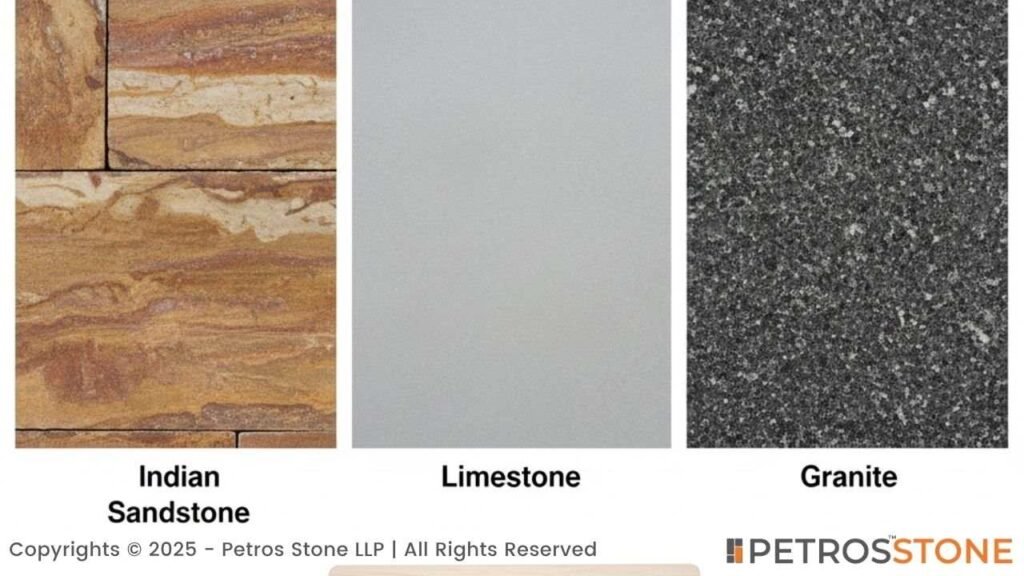
Indian Sandstone vs. Limestone
- Formation: Both are sea-deposit rocks suited for paving but differ in geological makeup.
- Characteristics:
- Limestone is stronger and can be moulded for design purposes.
- However, limestone is more prone to acid damage and offers fewer natural color variations than sandstone.
Sandstone provides richer shades, thermal comfort, and a more natural aesthetic.
Comparison of Maintenance
- Limestone requires sealing every 1–2 years and must be cleaned with neutral pH solutions.
- Sandstone requires sealing every 2–3 years and is easier to maintain.
Comparison of Cost
- Limestone: ₹500–₹900 per sq. meter
- Indian Sandstone: ₹400–₹800 per sq. meter (depending on finish).
Indian Sandstone vs. Granite
Granite is durable but lacks the slip resistance and thermal comfort of sandstone.
- Granite: Better suited for heavy-traffic commercial applications.
- Sandstone: Ideal for residential outdoor living areas because of its thermal comfort and natural character.
The uniform appearance of granite cannot match the warmth and individuality of sandstone.
Indian Sandstone vs. Manufactured Alternatives
Concrete and brick pavers are cheaper initially, costing about ₹300–₹600 per sq. meter.
- Advantages: Lower upfront cost and uniformity in appearance.
- Disadvantages: They lack the natural beauty, thermal comfort, and long-term value of Indian sandstone.
Unlike manufactured products, sandstone has character and gets better with age in the outdoors.
Buying Guidelines and Quality Control
Supplier Selection Criteria
- Reputable Source Verification: Choose suppliers with ties to the quarry industry and a quality record. They should provide documentation such as geological specs and quality certifications. Make sure samples are consistent in thickness and have minimal surface imperfections.
- Quality Inspection Points: Make sure color is consistent within batches, so any variations are within design tolerances. Make sure edge calibration is good, as you need to make precise cuts for installation. Ensure enough material to cover the whole project, plus 10-15% for waste and repairs that may come up in the future.
Summary
Indian sandstone is the perfect choice for the discerning homeowner, landscaper or architect who wants to combine natural beauty with practicality. The natural composition of the material provides inherent durability, weather resistance and safety features that manufactured alternatives can’t match. With the right selection, installation and maintenance Indian sandstone will perform for decades and add value to your property.
Key Takeaways
- Versatile Natural Stone: Indian sandstone offers unmatched versatility with colors ranging from beige, gold, and red to grey and green — each variety reflecting a distinct regional character.
- Affordable Yet Durable: With prices starting at just ₹400–₹450 per sqm (approx. $11–$20/sqm), it provides excellent value for outdoor projects without compromising quality or longevity.
- Slip-Resistant & Weatherproof: The natural riven surface ensures superior slip resistance, while its dense composition withstands heat, frost, and heavy foot traffic with ease.
- Multiple Finishes & Sizes: Available in riven, sawn, and calibrated finishes, and in standard sizes like 900×600mm and 600×600mm, it adapts to both traditional and modern design layouts.
- Long Lifespan with Low Maintenance: When properly sealed and maintained, Indian sandstone paving can last over 20–30 years, aging beautifully over time.
Feel free to get in touch for a free consultation, quote, and get a detailed understanding from our experts here at Petros®. Visit https://petrosstone.com/ or call +91-8446360361 and WhatsApp
Brown Granite
White Galaxy Granite
Blue Bahia Granite
Silver Cloud Granite
Black Pearl Granite
Dallas White Granite

Feel free to get in touch for a free consultation, quote, and get a detailed understanding from our experts here at Petros®. Visit https://petrosstone.com/ or call +91-8446360361 and WhatsApp
Brown Granite
White Galaxy Granite
Blue Bahia Granite
Silver Cloud Granite
Black Pearl Granite
Dallas White Granite

